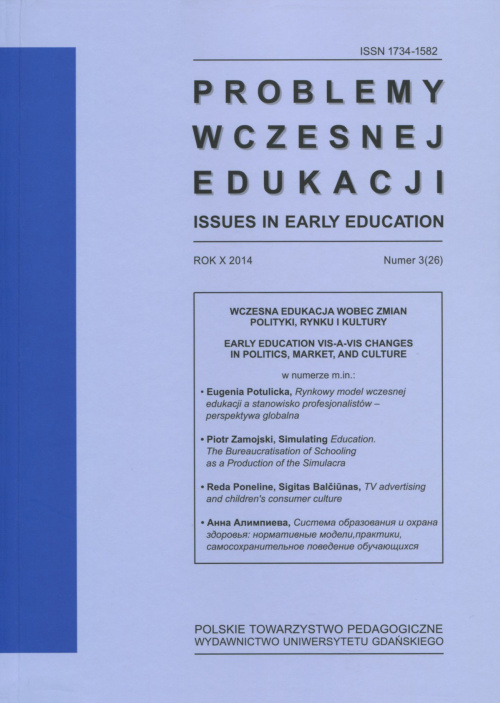TV advertising and children’s consumer culture
Keywords:
consumerism, children as consumers, children’s approach to advertisingAbstract
The paper presents the results of the research on consumer experience of 6–7 year old children investigated from the child’s perspective. The authors employed the method of interview with the child about TV advertisements, using stimulus material. The authors state that children recognize TV advertisements shown for them, make a distinction between advertisements and other television programmes, and have a certain knowledge about them. The study disclosed that the child’s approach to advertising depends on adults’ behaviour. It also revealed rudiments of critical assessment of advertising, which are mainly determined by negative experience of the child itself using the advertised item. According to the authors, in order to achieve the child’s critical attitude towards consumption and advertising, the adult who is together with the child must have similar features and values.
Downloads
References
Ali M., Blades M., Oate C.J., Blumberg F.C. (2009), Young children’s ability to recognizeadvertisements in web page designs. “British Journal of Developmental Psychology”, 27(1). Prieiga per EBSCO Publishing.
Babaalioutas D., Papadopoulou M. (2007), Teaching Critical Literacy through Print Advertisements:An Intervention with 6th Grade Students (Ages 11–12). “The International Journal of Learning”,14 (7). Prieiga per EBSCO Publishing.
Beasley R., Danesi M. (2002), Persuasive Signs: the Semiotics of Advertising. Berlin, Mouton deGruyter.
Berns R. (2009), Vaiko socializacija. Vilnius, Poligrafija ir informatika.
Bitinas B., Rupšienė L., Žydžiūnaitė V. (2008), Kokybinių tyrimų metodologija. Klaipėda, S. Jokužioleidykla-spaustuvė.
Brand J.E. (2008), Advertisements, Commercials, and the Development of a Child’s MulticulturalWorldview. In: Asamen J.K., Ellis M.L., Berry G.L. (eds.), The Sage Handbook of ChildDevelopment, Multiculturalism and Media. Los Angeles, SAGE Publications, Inc.
Butkus P., Stravinskienė J., Stravinskas T. (2012), Prekės ženklo poveikis vaiko vartotojo elgsenai.“Economics and Management”, 17(2).
Calvert S.L. (2008), Children as Consumers: Advertising and Marketing. “The Future of Children”,18(1). Prieiga per EBSCO Publishing.
Cook D.T. (2008), The Missing Child in Consumption Theory. “Journal of Consumer Culture”, 8(2). Available on SAGE journals (http://www.sagepublications.com).
Ekonomistė dr. Aušra Maldeikienė: finansiniu ugdymu turėtų rūpintis NVO (2014). [referred 2014-02-11]. Available on internet: http://www.vartotojai.lt/index.php?id=8887.
Europos ekonomikos ir socialinių reikalų komiteto nuomonė „Dėl jaunimui ir vaikams skirtosreklamos taisyklių”. 2012-09-18, Briusel [referred 2012-11-15]. Available on internet: http://eur-lex.europa.eu/LexUriServ/LexUriServ.do?uri=OJ:C:2012:351:0006:0011:LT:PDF.
Hill J.A. (2011), Endangered childhoods: how consumerism is impacting child and youth identity.“Media, Culture & Society”, 33(3). Available on EBSCO Publishing.
Jokubauskas D. (2003), Reklama ir jos poveikis vartotojui. Vilnius, InSpe.
Kardelis K. (2007), Mokslinių tyrimų metodologija ir metodai. Šiauliai, Lucilijus.
Khan S.K. (2006), Harnessing the Complexity of Children’s Consumer Culture. “Complicity: AnInternational Journal of Complexity and Education’, 3(1). Available on EBSCO Publishing.
Kline S. (1993), Out of the Garden: Toys, TV, and Children’s Culture in the Age of Marketing. London, New York, Verso.
Kotler Ph., Keller, K.L. (2007), Marketingo valdymo pagrindai. Klaipėda, Logitema.
Larson M.S. (2001), Interactions, Activities and Gender in Children’s Television Commercials:A Content Analysis. “Journal of Broadcasting and Electronic Media”, 45(1). Available onEBSCO Publishing.
Marshall D. (2010), Understanding Children as Consumers. SAGE Publications Ltd.
Martens L., Southerton D., Scott S. (2004), Bringing Children (and Parents) into the Sociology ofConsumption: Towards a Theoretical and Empirical Agenda. “Journal of Consumer Culture”,4(2). Available on SAGE journals (http://www.sagepublications.com).
Merriam S.B. (2009), Qualitative research: A guide to design and implementation. 3rd ed. SanFrancisco, CA, Jossey-Bass.
Pikturnienė I., Grod I. (2006), Vartotojų elgsenos kaitos tendencijos. “Marketingas”, 11(23).
Pilkauskaitė-Valickienė R. (2011), Reklamos supratimas ikimokykliniame amžiuje [referred2011-10-18]. Available on internet: http://www.ikimokyklinis.lt/index.php/straipsniai/bendristraipsniai/reklamos-supratimas-ikimokykliniame-amziuje/5784.
Ponelienė R. (2014), Priešmokyklinio amžiaus vaikų atsparumo vartotojiškumui ugdymo(si) šeimojepedagoginės sąlygos: daktaro disertacija. Šiauliai, BMK leidykla.
Rossiter J.R. (1979), Does TV Advertising Affect Children? “Journal of Advertising Research”. Available on EBSCO Publishing.
Rowntree N. (2008), Children damaged by aggressive marketing and a negative media. “Children& Young People Now”, 2(27). Available on EBSCO Publishing.
Rubin R.S. (1974), The Effect of Cognitive Development on Children’s Responses to TV Advertising.“Journal of Business Research”, 2. Available on EBSCO Publishing.
Ruckenstein M. (2010). Time scales of consumption: Children, money and transactional orders.“Journal of Consumer Culture, 10(3). Available on SAGE journals (http://www.sagepublications.com).
Rumbo J.D. (2002), Consumer Resistance in a Word of Advertising Clutter: The Case of Adbusters.“Psychology and Marketing”, 19(2). Available on EBSCO Publishing.
Stonkienė M. (2013), Ikimokyklinio amžiaus vaikams žiniasklaida daro didesnį poveikį. [referred2013-09-30]. Available on internet: http://www.bernardinai.lt/straipsnis/2013-09-26-prof-drmarija-stonkiene-ikimokyklinio-amziaus-vaikams-ziniasklaida-daro-didesni-poveiki/107630.
Swallow A.L. (1997), Images of Female Children in TV Commercials [referred 2007-12-17]. Available on internet: http://people.wcsu.edu/mccarneyh/acad/swallow.html.
Tereškinas A. (2007), Esė apie skirtingus kūnus. Vilnius, Apostrofa.
Žiniasklaidos tyrimų apžvalga 2012 [referred 2013-04-02]. Available on internet: http://www.tns.lt/ data/files/Metines_apzvalgos/Ziniasklaidos%20tyrimu%20apzvalga%202012.pdf.
Владыкина T. (2006), Привычка к лучшему с пеленок. [referred 2007-01-20]. Available on internet: http://www.rg.ru/2006/04/27/reklama.html.
Линн С. (2006), Проданное детство. Москва, Добрая книга.
Молчанов И., Сороченко В. (2007), Детская реклама. [referred 2007-01-20]. Available on internet: http://www.psyfactor.org/recl15.htm.

 Academic Scientific Journals
Academic Scientific Journals





